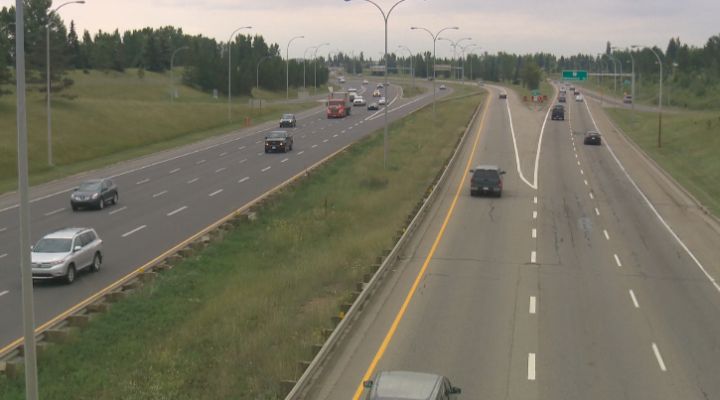EDMONTON – A one-month pilot project has concluded drivers need to slow down in order to speed up the flow of traffic during rush hour on one of Edmonton’s busiest roads.

The pilot was done August 11 to September 4 on the westbound leg of Whitemud Drive between 111 Street and 159 Street.
Digital roadside signs were used to encourage drivers to slow down to suggested speeds which changed with traffic volume.
“The net effect of giving drivers what we call advisory driving speeds was that average speeds during peak periods actually increased by up to 30 km/h” said Dr. Tony Qiu, University of Alberta Centre for Smart Transportation director.
READ MORE: Whitemud Drive speed suggestion project aims to improve traffic flow
What researchers found was on-ramp congestion caused drivers to brake quickly, creating a ‘wave’ of braking that moved upstream on the road. It resulted in congestion remaining long after the first vehicle hit the brakes.
“When drivers followed the advisory speed, congestion at on-ramps reduced considerably,” said Wai Cheung, City of Edmonton Transportation Services.
“There was more room between vehicles on the freeway for merging vehicles to slide safely into the flow of traffic.”
Providing suggested speeds cut the length of overall peak congestion from one hour to 40 minutes. It also reduced travel time between 122 Street and 159 Street by 10 per cent.
READ MORE: Speed limit to remain 80 km/h on Whitemud Drive
Additionally, there were fewer collisions during the pilot project. There were two crashes, compared to five or six during the same period in the previous three years.
The City of Edmonton and University of Alberta Faculty of Engineering conducted the pilot.
Researchers used real-time vehicle flow and speed data from sensors embedded in the Whitemud and its ramps.
U of A software processed the information and gave recommendations to the city, which then sent advisory speeds to the digital signs.


Comments